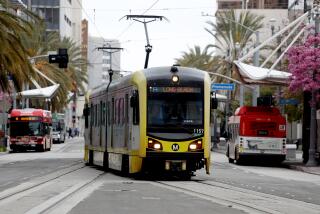New MTA chief is 38-year transit veteran
- Share via
Art Leahy, whose mother and father helped run Los Angeles’ celebrated streetcars and who himself once worked as a bus driver, was approved Thursday as the new chief executive of the Metropolitan Transportation Authority.
Leahy, currently the top transit official in Orange County, will soon take the reins of one of the nation’s largest transportation agencies, with a $3.4-billion budget, 9,775 full- and part-time employees and nearly 486 million boardings on its buses and trains last year. He replaces Roger Snoble, who is retiring after seven-plus years on the job.
In choosing Leahy, 60, the MTA board settled on a leader who is a 38-year transit veteran. But he has spent the last eight years in a county that has a higher percentage of commuters who drive to work alone than Los Angeles County (77.4% versus 72.3%), a lower percentage who take mass transit to work (3% versus 7%) and a smaller proportion of commuters who carpool (11.3% versus 11.6%), according to the Census Bureau.
The move is also a coming home of sorts: Leahy began his career at the MTA but was unceremoniously fired in 1996 during a management shake-up by then-Chief Executive Joseph Drew. Leahy learned he had been sacked after coming home from a transit conference in Kansas City and finding a notice taped to his front door.
(As it happened, Drew only lasted nine months at the MTA before he quit, citing infighting and “hypercriticism” of his performance -- both indicative of the often-fiery politics that surround the MTA.)
Leahy went on to head the Minneapolis-St. Paul transit agency before assuming leadership of the Orange County Transportation Authority in 2001.
Leahy said the MTA job was attractive because of the size of the agency, its mission and the location in Los Angeles, where he grew up. “I believe in transit, and I believe in what the MTA is doing and how it contributes to the health and vitality of Los Angeles County,” Leahy said. “It’s a great place, and it ought to have a great transit system.”
The MTA board unanimously voted to give Leahy a four-year contract with a starting annual salary of $310,000 plus a housing allowance of $20,000 -- about the same as Snoble’s deal. Leahy earns $309,000 at OCTA.
Leahy’s mother and father met after World War II while both ran streetcars for the old Los Angeles Railway. As the streetcars vanished, Leahy’s father moved to buses and became a driving instructor.
In the early 1970s, Leahy decided to try his hand at driving a bus and was trained by his father. He started at $18 a day and ended up driving routes around Los Angeles for three years.
“Bus driving is a tough way to make a living,” Leahy said. “I became a much more determined student because of it and I realized I needed an education. Going through bus driver training was my equivalent of going to boot camp.”
Leahy eventually was hired to study the efficiency of bus routes for the Southern California Rapid Transit District, which would evolve into the MTA. He later was put in charge of operating the bus and rail system.
His experience in rail was a draw when he began in Orange County, where officials hoped to build the so-called Centerline light rail system. But the $1-billion project never found federal funding or gained support from voters or public officials. It was shelved in 2005.
Leahy fared better with other projects. The agency purchased the 91 Freeway toll lanes and widened both the 5 and 22 freeways. OCTA also began upgrading Metrolink commuter rail service so that by 2010 it would run every half hour in Orange County for most of day, with more parking, new transit villages at stations and improved bus connections.
Among the challenges facing Leahy at the MTA are:
Negotiating a labor contract -- the current pact expires in June -- with about 8,000 MTA employees, including bus and rail operators and mechanics.
Replacing $409 million in state money lost as part of the recent budget adopted by the Legislature while avoiding service cuts.
Building the dozens of projects, including the subway extension, promised to voters as part of the half-cent sales tax hike campaign last year.
“A federal transportation bill is going to be reauthorized this year, and all indications are that this administration is going to place a heavier emphasis on public transit than in the past,” said Ed McSpedon, who previously oversaw rail construction for the MTA and is now a senior vice president at the engineering firm HNTB. “We have to be plugged in and make sure enough of that money comes here.”
--
More to Read
Sign up for Essential California
The most important California stories and recommendations in your inbox every morning.
You may occasionally receive promotional content from the Los Angeles Times.













